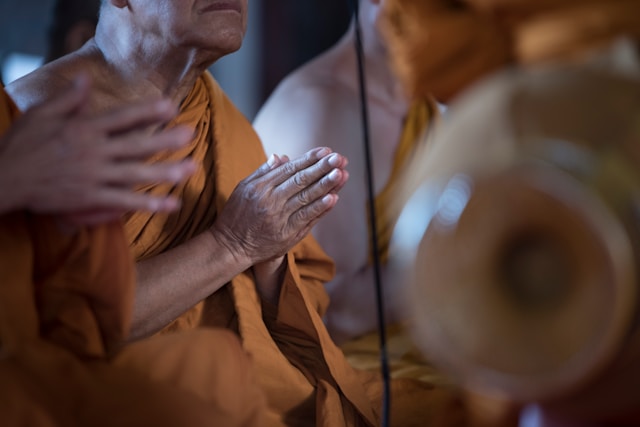Four Kinds of Faith
Tibetan Buddhist lama and scholar Khenpo Sodargye on the type of faith that makes practice transcendent The post Four Kinds of Faith appeared first on Tricycle: The Buddhist Review.

When lama and scholar Khenpo Sodargye first came to the West in the 1980s, he noticed how averse many Western practitioners were to the idea of faith. Perhaps due to the more theistic connotations of faith in much of Western religion, students told Sodargye that they came to Buddhism to “get away” from the idea of faith. While he appreciated their drive towards using reason and logic in their spiritual journeys, he felt that their practice was missing a crucial heart element. It is precisely the emotional wisdom arising from faith in the three jewels and the guru, Sodargye says, that helps Buddhist practice to become transcendent. Not separate from logic, this faith is made steadfast through practice and reflection, as Sodargye notes, “true faith in Buddhism is developed by verifying and validating the teachings through our own experience and insight, not through mere belief.”
In his guide Tibetan Buddhism: A Guide to Contemplation, Meditation, and Transforming Your Mind, Sodargye expounds on how this faith arises, breaking it down into its four component parts: vivid faith, eager faith, confident faith, and irreversible faith.
— Eds.
Vivid Faith
Vivid faith, as defined in Patrul Rinpoche’s The Words of My Perfect Teacher, is the faith that is inspired in us by thinking of the immense compassion of the buddhas and great teachers.
We might experience vivid faith when seeing representations of the Buddha’s body, speech, and mind, including images of the Buddha, scriptures, and stupas, or after encountering a great teacher or an eminent master in person or whose inspiring life story or great qualities we just heard described. Touched by their vast compassion, we feel lighthearted, elated, or deeply moved.
When closely examining vivid faith, we realize it is primarily an intense emotional state. This state, which can include excitement, awe, ecstasy, and gratitude, wavers and doesn’t last long. Many people can’t help but shed tears when they see the Buddha’s statue, hear sutras chanted, or prostrate themselves in front of a stupa for the first time. These people may weep emotionally when encountering a great Buddhist teacher, saying, “Dear teacher, you look so compassionate. The more I look at you, the more I want to cry!”
I have met dharma students who cried very easily at the beginning. But perhaps this exhausted their reservoir of tears, because later they shed not even a single tear of faith. I often tease my disciples, “Maybe it’s better to ‘cry smartly,’ so there is always some stock of tears left for your future use.”
Vivid faith generates great merit, as related in a story in the Miscellaneous Treasures Sutra:
A girl was riding a chariot on her way to a garden when she happened to meet the Buddha, who was heading to the city. She immediately gave way to the Buddha, and owing to his majestic appearance, she was filled with joy and appreciation. This vivid faith brought her rebirth in the god realm.
When Dakini Muntso Rinpoche was heading to the Larung Gar Nun’s Dharma Hall for the consecration of the site, I saw many laypersons cry upon seeing her, shedding tears of joy and faith. A non-Buddhist might think the laypersons were silly, asking, “Why did they cry like that?” The answer is that their tears signaled the awakening of their dormant virtues.
Vivid faith is important for a Buddhist. If you remain emotionless like a rock when seeing an image of the Buddha or meeting a teacher, or even worse if you give a scornful or disdainful look, the blessings from buddhas, bodhisattvas, and teachers cannot enter your mind.
Their tears signaled the awakening of their dormant values.
We don’t need to question people experiencing vivid faith, asking, “Why are they so emotional? Why are they crying? Why are they so ecstatic?” When someone jumps with joy upon seeing their teachers, we should not think they are abnormal. Their joy simply reflects their vivid faith.
Eager Faith
Eager faith arises when we are eager (1) to be free of the sufferings in the three lower realms of hell beings, animals, and hungry ghosts; (2) to enjoy the happiness of the three higher realms of humans, demigods, and gods; and (3) to eventually attain ultimate liberation when we hear what these realms are like. Eager faith also arises when we long to engage in positive actions because we understand the benefits they bring, and to avoid negative actions because we acknowledge the harm they cause.
Compared to the temporary excitement or ecstasy of vivid faith, eager faith arises when we start to understand the Buddha’s teachings. This means eager faith is more reliable and stable. For example, we may not at first understand the need for engaging in positive actions. But as we become more aware of the benefits of positive actions through studying Buddhist teachings, we’re less likely to stumble. For this reason eager faith enables us to progress steadily on the path to liberation, and to eventually free ourselves from all suffering. The Discourse on Meeting of the Father and the Son (Pitaputrasamagama Sutra) says:
Hearing the Buddha’s teachings in dharma assemblies,
Thus generating pure faith and ultimate understandings,
And then diligently practicing the dharma that leads to bodhi,
One will be free from the samsaric ocean of birth and death.
Eager faith is far more powerful than vivid faith, but both kinds of faith, together with the other two kinds yet to be introduced, are important along the path to liberation. Faith itself is like an admission ticket to liberation, without which one cannot enter the “Dharma Theater” to watch the miraculous show of the three jewels.
Confident Faith
Confident faith is faith in the three jewels from the depth of our hearts once we understand the three jewels’ extraordinary qualities and the power of their blessings. With this faith, we deeply trust in the three jewels and become very certain that they are the only unfailing refuge, or protection. By taking refuge we commit ourselves to the Buddhist path and seek protection from the suffering in samsara. Thus, whatever circumstances we are in—happy, sad, painful, ill, living, or dead—the three jewels are always with us.
Confident faith is to the bone, not just skin deep. Confident faith brings total trust in the three jewels, so a practitioner says, “In this life and in many lives to come, whether happy or in pain, I trust you in everything. You are my only refuge.” This confident faith is like an orphan who places total trust in the person who wholeheartedly helps them.
How many people in the world really understand the meaning of taking refuge in the three jewels? There are some Buddhists who received stamped-and-signed refuge certificates from a temple or a master in a refuge ceremony a dozen years ago, yet they haven’t generated total trust in the Buddha, rendering their refuge (and accompanying certificates) superficial. As true Buddhists, we should aim to free our minds from doubt and pray to the three jewels with full trust and genuine confidence.
Confident faith is not blind faith based only on someone praising the extraordinary qualities of the Buddha. Most ordinary dharma students start to generate confident faith through systematic hearing and contemplation. For example, through studying the “Pramanasiddhi” chapter of The Commentary on Valid Cognition (Pramaṇavarttika), we become convinced that the Buddha is a valid source of knowledge for those seeking spiritual freedom. Through studying the Noble Sutra of Recalling the three jewels, we no longer doubt the inconceivable qualities of the three jewels.
Confident faith is more solid than the first two kinds of faith and cannot be shaken by temporary circumstances and events. Yet there remains a chance, however miniscule, for confident faith to regress. Therefore, we should all strive for irreversible faith.
Irreversible Faith
Irreversible faith is the deepest level of faith, remaining unshakable under all circumstances no matter how difficult, even at the cost of our own lives. When we truly realize the ultimate truth of all phenomena, we’ll give rise to irreversible faith and take the ultimate refuge in the ultimate three jewels, which is none other than the very nature of our own mind. When irreversible faith arises, it’ll become integral to us—in our heart, mind, blood, and bone marrow.
As Patrul Rinpoche says in The Words of My Perfect Teacher:
As you develop a faith quite beyond the commonplace, by its power the blessings of the teacher and of the three jewels will enter you. Then true realization will arise, and you will see the natural state as it really is. When that happens, you will feel an even more extraordinary and irreversible faith and confidence in your teacher and in the three jewels. In this way faith and the realization of the natural state support each other.
During this degenerate age, irreversible faith cannot surface without serious study, thorough contemplation, and diligent meditation practice. But practitioners with irreversible faith, who acquire knowledge and direct experience, won’t waver for one microsecond even if the whole world denounces Buddhism.
I remember a conversation with Khenpo Norbu, a monk who came to Larung Gar at roughly the same time as I did. We reflected on our faith, agreeing that although neither of us dared suggest we’d attained realization, our faith in the dharma and the Buddha was indeed hard to regress. As we both age we feel more and more that the only refuge is the three jewels, and that everything else—wealth, fame, status, relationships—is unreliable, transient, dreamlike, and meaningless.
I sincerely hope every Buddhist takes authentic refuge in the three jewels. This may start from vivid faith, gradually evolving into eager faith, and then confident faith, and finally becoming irreversible faith. As our faith deepens, we can start to significantly contribute to Buddhist activities such as propagating the dharma and benefiting sentient beings. The story behind the Kanishka Stupa, one of the tallest buildings in the ancient world, reflects this:
Kanishka, the king of the Kushan Empire, was an aggressive, hot-tempered, and rigid person who liked to hunt. Once in a forest he spotted a little white rabbit, so he went after it with his bow and arrow. Suddenly, the rabbit disappeared, and a boy appeared making a meter-high stupa.
The king asked, “Why are you making this?”
The boy answered, “Before his parinirvana, Shakyamuni Buddha foretold that five hundred years later, a king named Kanishka would erect a stupa on this spot and contribute greatly to Buddhism. I am here to give you a hint with this mud stupa.” After saying that, the boy disappeared.
Hearing this King Kanishka instantly generated faith and a sense of joy, thinking, “How extraordinary was Shakyamuni Buddha! He knew I would be here! Since the Buddha has prophesied, I should convert to Buddhism.” After his conversion to Buddhism, gradually he became an openhearted, benevolent, and faithful ruler.
He not only believed in Buddhism but also encouraged its teachings. He built a dharma hall in his palace, and invited different learned masters to give teachings on a daily basis. Through his study, King Kanishka’s faith was getting stronger. As he progressed further on the path, his trust in the Buddha and the dharma ripened.
Soon King Kanishka noticed that each master had his own interpretation about the same section of sutra. Befuddled, the king didn’t know which one he should follow, so he asked Arya Parshva, a renowned Buddhist monk, why so many variations existed. Arya Parshva answered: “It has been five hundred years since Shakyamuni Buddha’s parinirvana. Various Buddhist schools disagree with each other on the interpretation of the Buddha’s teachings. It is time to organize the Fourth Buddhist Council, which will mark an important turning point for Buddhism.”
Knowing this could bring great benefits to sentient beings, the king adopted Arya Parshva’s suggestion and gathered five hundred monks in Kashmir, headed by Vasumitra, to systematize the Abhidharma texts. The main fruit of this council was the vast commentary known as the Great Exegesis (Mahavibhasa). This council also signaled the development and transmission of Mahayana Buddhism to China. This story shows that vivid faith arose when King Kanishka first heard the Buddha’s prophecy. After he systematically studied and contemplated the Buddha’s teachings, he generated the mind of renunciation and devoted himself to propagating the dharma, a sign of confident faith.
The faith of many dharma students follows a similar progression. Inspired by their first encounter with a great teacher or the three jewels, they are guided to Buddhism by their karmic connection even though they don’t know much about the dharma. Later they develop confident faith through systematic study and contemplation. As they advance further on the path to liberation, they strive to eventually attain irreversible faith.
◆
From Tibetan Buddhism: A Guide to Contemplation, Meditation, and Transforming Your Mind by Khenpo Sodargye. © 2024 by Khenpo Sodargye. Reprinted in arrangement with Shambhala Publications, Inc. Boulder, CO

 Astrong
Astrong 




















![The 2026 AI Search Benchmark Every SEO Leader Needs [Webinar] via @sejournal, @lorenbaker](https://www.searchenginejournal.com/wp-content/uploads/2025/11/1-259.png)





(1).jpeg)






